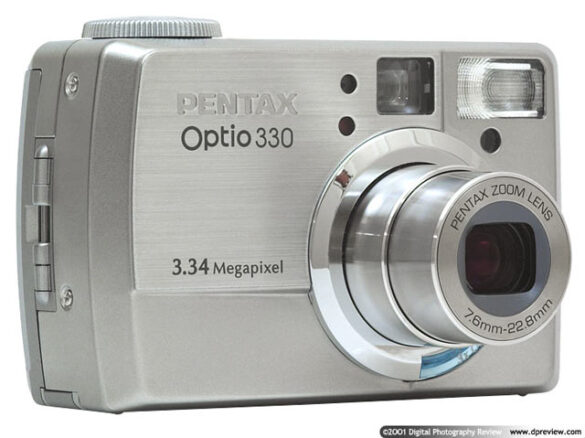Released in mid‑2001, the Pentax Optio 330 marked Pentax’s bold entry into the burgeoning world of consumer digital cameras. At the time, it stood out as the smallest 3‑megapixel camera with 3× optical zoom on the market. This pocket-sized powerhouse delivered solid performance and surprising versatility, striking a unique balance between portability and capability.
Design Vision & Market Impact
The Optio 330 was designed with everyday portability in mind. Its sleek, stainless-steel chassis and compact dimensions (92 × 62 × 31 mm) meant it could slip easily into a pocket or small purse dpreview.com. Pentax enhanced usability further with an alarm clock and world-time function, cleverly embedding lifestyle tools alongside imaging features.
This design-forward approach made the Optio 330 a hit among travelers, students, and professionals seeking a capable yet inconspicuous digital camera—earning it a distinct place in early‑2000s photographic history.
Core Specifications
- Sensor: 3.3 MP CCD (1/1.8″), producing 2,048 × 1,536-pixel JPEGs
- Lens: 37–111 mm equivalent, f/2.6–4.8, 3× optical (plus 2× digital) zoom
- Focusing: TTL contrast-detection with 7‑point AF and spot AF, plus manual options
- Shutter: 15 s – 1/2,000 s, with manually selectable aperture/shutter in Manual mode
- Metering: 6‑segment, center-weighted, spot exposure metering
- Display: 1.6″ LCD with 4× playback zoom
- Viewfinder: Optical real‑image, dioptric adjustment
- ISO: 100 and 200 (Auto)
Creative & Convenience Features
- Exposure Modes: Included Auto, Program, Manual, Night Scene, Movie, and Multi‑Exposure
- Color Filters & Effects: B/W, sepia, saturation/contrast presets
- White Balance: Auto, Daylight, Shade, Tungsten, Fluorescent, Manual
- DPOF Support: Print formatting control on compatible printers
- Lifestyle Tools: Alarm clock, world time, self‑portraits with an easy rotating LCD
Image Quality & Performance
Low-Light Capabilities
The 1/1.8″ CCD sensor and f/2.6 aperture allowed exposures as long as 15 seconds. Impressively, tests showed usable images at light levels as low as 0.67 lux—roughly one-sixteenth of a foot-candle. Noise remained well-controlled at ISO 100–200.
Lens Quality
The 3× optical zoom lens, with two double-sided aspherics, delivered sharp, distortion‑managed images. Wide-angle barrel distortion reached ~1.2%, with negligible pincushion at telephoto. Chromatic aberration was minimal, and lens coatings reduced flare .
Flash & Metering
Built-in flash had a useful range—0.5–3.7 m (wide) and 1.3–2 m (tele). Still, DPreview noted occasional flash underexposure or color casts, and recommended manual white balance fixes.
Handling & Usability
The tight shutter lag and limited buffer (two‑shot burst then pause) meant the camera was not suited for fast action, but managable for everyday scenes. Its user interface—a simple menu with OK button selection—was intuitive and remained accessible even during image playback .
The swing-out LCD enabled easy self-portraits, a novel feature in 2001 . Menus included useful info like histogram, exposure compensation (±2 EV), icon guides, and mode memory for setting shortcuts.
Storage & Power
- Memory: CompactFlash Type I cards, standard 16 MB included
- Battery: 900 mAh Li‑ion rechargeables; around 72 minutes of active shooting (with LCD)
- Connections: USB 1.1, composite video out, optional IR remote, and TV playback
Pros & Cons
Pros:
- Ultra-compact 3× optical zoom with 37–111 mm range
- Creative manual/manual-exposure modes and long exposures
- Low-light capability with slow shutter to 15 s
- Bonus lifestyle tools: alarm clock, world-time, self-scenes
- 3× digital zoom on top of optical for flexibility
Cons:
- Buffer allows only two quick shots before pause
- Slow AF and shutter lag limit action shooting
- Flash underexposure/color in certain situations
- Small 1.6″ LCD may be awkward for framing or playback
Legacy and Collector Value
The Optio 330 is remembered fondly by vintage digital camera enthusiasts. Its compactness, surprising control, and eclectic feature set—balanced with a sturdy metal body—make it a treasured piece of photographic history. Reddit conversations (e.g., r/VintageDigitalCameras) frequently show owners praising its build quality and nostalgic charm.
Issues like older memory card compatibility (some models prefer ≤1 GB CFs) and finding rare accessories (like USB cables) are typical in vintage camera communities . Yet these quirks add to its character and collector appeal.
Who Should Own One Today?
The Pentax Optio 330 isn’t a high‑performance DSLR or modern compact but excels as:
- A photography history piece—portable, feature-rich, and iconic
- A learning tool for experimenting with manual exposure and slow shutter
- Niche low-light shooting—great for nightscapes and long exposures
- Collectors and analog enthusiasts who appreciate vintage digicam design
In Summary
The Pentax Optio 330 was a remarkable early-2000s release that smartly blended compact design, manual control, and lifestyle appeal. Its 3× optical zoom, long-shutter capabilities, and quirky extras like alarm clocks and world clocks make it a standout design experiment — and it continues to be cherished by enthusiasts for its character and capability.
Though it lacks modern conveniences like fast burst shooting or Wi‑Fi, the Optio 330 remains a brilliant example of thoughtful, human-centric design in digital cameras. Whether you’re exploring photographic nostalgia or just hunting for something distinctive, this little 3.3 MP marvel still surprises and delights.

